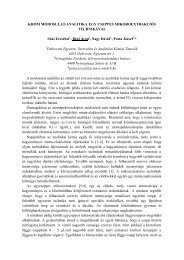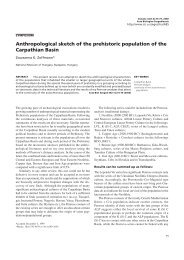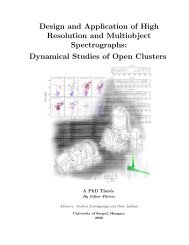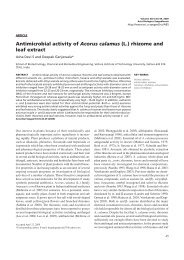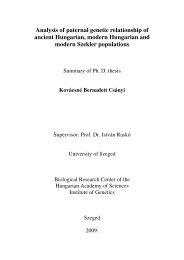principles of extraction and the extraction of semivolatile organics ...
principles of extraction and the extraction of semivolatile organics ...
principles of extraction and the extraction of semivolatile organics ...
Create successful ePaper yourself
Turn your PDF publications into a flip-book with our unique Google optimized e-Paper software.
76 <strong>principles</strong> <strong>of</strong> <strong>extraction</strong><br />
Absorption Adsorption<br />
(large pores)<br />
Adsorption<br />
(small pores)<br />
Figure 2.19. Schematic representation <strong>of</strong> absorptive versus adsorptive <strong>extraction</strong> <strong>and</strong> adsorption<br />
in small versus large pores. (Reprinted with permission from Ref. 51. Copyright 6 2000 Elsevier<br />
Science.)<br />
become a rate-limiting process in controlling sorption <strong>of</strong> an analyte. The<br />
analyte may interact with a solid-phase sorbent in at least four ways:<br />
1. Through absorption, <strong>the</strong> analyte may interact with <strong>the</strong> sorbent by<br />
penetrating its three-dimensional structure, similar to water being absorbed<br />
by a sponge. Three-dimensional penetration into <strong>the</strong> sorbent is<br />
a particularly dominating process for solid-supported liquid phases. In<br />
<strong>the</strong> absorption process, analytes do not compete for sites; <strong>the</strong>refore,<br />
absorbents can have a high capacity for <strong>the</strong> analyte.<br />
2. The analyte may interact two-dimensionally with <strong>the</strong> sorbent surface<br />
through adsorption due to intermolecular forces such as van der Waals<br />
or dipole–dipole interactions [53]. Surface interactions may result in<br />
displacement <strong>of</strong> water or o<strong>the</strong>r solvent molecules by <strong>the</strong> analyte. In <strong>the</strong><br />
adsorption process, analytes may compete for sites; <strong>the</strong>refore, adsorbents<br />
have limited capacity. Three steps occur during <strong>the</strong> adsorption<br />
process on porous sorbents: film di¤usion (when <strong>the</strong> analyte passes<br />
through a surface film to <strong>the</strong> solid-phase surface), pore di¤usion (when<br />
<strong>the</strong> analyte passes through <strong>the</strong> pores <strong>of</strong> <strong>the</strong> solid-phase), <strong>and</strong> adsorptive<br />
reaction (when <strong>the</strong> analyte binds, associates, orinteracts with <strong>the</strong> sorbent<br />
surface) [54].<br />
3. If <strong>the</strong> compound is ionogenic (or ionizable) in aqueous solution (as<br />
discussed earlier), <strong>the</strong>re may be an electrostatic attraction between <strong>the</strong>










